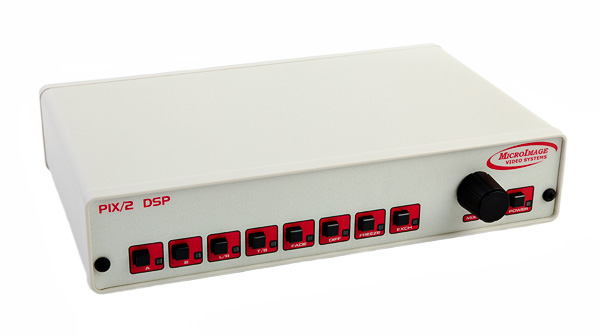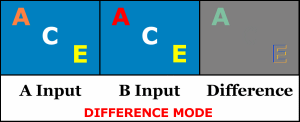Description
The MicroImage Video Systems Screen Splitter has become the de facto standard for many applications. A robust feature set, precise video specifications and reliable operation at an affordable price are just a few of the reasons so many return to this product time and time again. Now in it’s fourth generation, the MicroImage screen splitter is far ahead of the competition in terms of features, modes and refined operation.
?Operational modes include fully adjustable horizontal or vertical split screen, fade and difference. In Split mode, the two images can be split on the screen showing a portion of each image, either side by side or top and bottom. Fade mode will mix the two video sources together as an overlay. Difference mode is similar to fade except that it shows only the difference between the two video signals (using subtraction or by adding a negative image). A rotary control adjusts the position of the split screen and the amount of fade or difference. The Exchange button reverses the camera display positions (i.e. B camera on left or top). In addition, the B input video memory can be frozen by pressing the Freeze button. All settings are remembered when power is removed.
Center Split Mode is a feature that will display the center half of each camera image in either side by side or top and bottom modes. The split position is not adjustable in this mode. A rear panel DIP switch enables this mode of operation.
A border line can be generated at the split point which makes it easier to discern the two separate images. The border size can be set to 0 (off), 1, 2 or 3 pixel widths and can be set to one of eight colors (gray, yellow, cyan, green, magenta, red, blue or black). The operation manual explains how to enable it and set the size and color.
Two simultaneously displayed images allow precision comparisons that are necessary in Forensics, Bio-Medical and industrial production. Two camera, side-by-side comparisons can now be made with an ease never before possible. In pathological or oncological situations, tissue samples can be quickly compared. Body movement analysis in sports and sport medicine are routinely used applications for the PXD510E.
Forensic medicine and criminal forensics are areas where side-by-side or overlay comparisons are of the utmost importance. Items such as tissue and blood cells, ballistic samples and fibers can all be displayed for comparison on a video monitor. Since the PXD510E is fully compatible with most video printers and frame grabbers, a permanent copy can be made or a video projector can be used to display the findings to an audience, such as in a courtroom.
Commonly used in courtroom applications, the PXD510E can allow a remote defendant and courtroom participants such as witnesses, prosecutor and jurors to be visible on the same screen and recorded together in real time. The PXD510E is ideal for observation in behavioral sciences such as comparing twins, before/after comparison or historical similarity.
The PXD510E is often used in transportation applications where two sides of a transit car, both directions of a road or both sides of a tunnel or bridge need to be viewed or recorded at the same time. The PXD510E is a valuable resource in manufacturing such as production variation/deviation investigations.
The PXD510E uses state-of-the-art, high performance digital signal processing (DSP) to maintain the highest quality video signals. This assures consistent matching between the two video sources. Either video input can be from composite video, S-Video or a B&W video signal. The PXD510 will always produce both composite and S-Video regardless of input signal type.
The PXD510E family of products work with a variety of cameras. Each unit provides the proper signals and connectors to work correctly with the intended camera type. The PXD510E will work with almost any two cameras (or other video sources) that have a composite or S-Video output signal and meet the NTSC or PAL standard. Genlock is NOT required.
In the past, the only solution to displaying two images side by side has been to use Genlock capable cameras or expensive frame synchronizers. Now MicroImage Video Systems has incorporated two high performance, full frame synchronizers (time base correctors) into an advanced split screen and fade controller. The result is that virtually any two standard definition video sources can be mixed or placed side by side on the same screen. It is compatible with most cameras, VCRs, camcorders and other products that generate video.
The standard RS232 control allows the PXD510E to be controlled by a computer or other device or from a remote location. The RS232 control also allows access to the units internal SMPTE style color bar generator and other advanced options. See the protocol definition manual for additional information.
A Rack mounting kit is available as an option. RoHS products are available for those countries that require units with RoHS compliance. RoHS units are lead-free.
The PXD510E is available completely packaged (cased) or as a board level product for OEM applications. Power is provided by a universal desktop power supply (included with cased products) or it can be operated from +12VDC (negative ground). Board level products do not include the power supply and a 12VDC regulated power source must be provided.? The unit is packaged in a durable metal enclosure with plastic end bezels.?Board Level, OEM and Custom products are also available. Please contact MicroImage Engineering for additional information.
The PXD510E has a one year parts and labor limited warranty.
|
Key Specifications |
|||||||||||||||||||||||||||||||||||||||||||||||||||||||||||||||||||||||||||||||||||||||||||||||||||||||||||||||||||||||||||||||||||||||||||||||||||||||||||||||||||||||||||||||||||||||||||||||||||
|
|||||||||||||||||||||||||||||||||||||||||||||||||||||||||||||||||||||||||||||||||||||||||||||||||||||||||||||||||||||||||||||||||||||||||||||||||||||||||||||||||||||||||||||||||||||||||||||||||||






